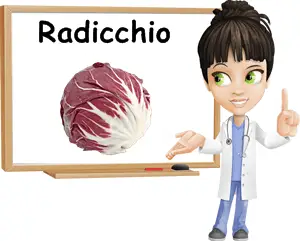Italian chicory, or radicchio (Cichorium intybus Linnaeus), is a vegetable very similar in appearance to a small red cabbage. Radicchio is known to improve focus by stimulating the nervous system. Due to its beneficial action on the liver and gall bladder, the vegetable aids digestion and helps purify the blood. Moreover, it has been shown to regulate blood glucose levels and reduce appetite as a result of a good dietary fiber content, improve mineral absorption at the level of the gastrointestinal tract as well as exhibit detoxification properties.
Radicchio boasts a good nutrition profile and is an excellent source of vitamin K, a nutrient which supports blood coagulation and bone mineralization, but also cardiovascular health by preventing calcium deposits from forming on the inside of artery walls. Radicchio is a good source of dietary fiber, promoting digestive health, regulating transit time with benefits such as constipation relief and better management of hemorrhoids symptoms.

What is radicchio and where does it come from?
Also known as Italian chicory, radicchio is a reddish leafy vegetable native to, you’ve guessed, Italy. It’s actually quite popular in Italian cuisine, often eaten in salads along with endives and chicory.
What does radicchio look like?
Radicchio looks very similar to a small cabbage head in the sense that it has tightly wrapped cabbage-like leaves of a red, reddish-purple color with large white veins. Other varieties are more like elongated, red endives, while some are white-colored. Usually, different varieties are named after the northern Italian cities they are grown in, for example: radicchio di Treviso.
What does radicchio taste like?
Radicchio has a mildly bitter taste and somewhat chewy, fleshy texture. Believe it or not, culinary experts recommend enjoying this vegetable by itself, not in salad combinations. You can grill it and add a sprinkle of olive oil and make the perfect side dish to an exquisite steak or add it to popular Italian recipes such as pasta or risotto. Just like ordinary chicory, radicchio roots can be made into a coffee substitute, although the plant has no caffeine.
Also see benefits of chicory.
Radicchio was used by the ancient Egyptians to cure liver and gall bladder problems, infections, purify the blood and reduce hunger pangs.
Both radicchio leaves and root are of great medicinal importance, boasting an above-average nutritional profile. See below what are the top 8 health benefits of radicchio.

What are the benefits of Radicchio?
Stimulates digestive juices
The compounds that give radicchio its natural bitterness make it an efficient digestion aid. Eating radicchio stimulates the liver to produce more bile, a fluid that helps us digest fatty foods. Regular consumption is recommended for conditions such as gallbladder problems, gastritis or in cases of poor diets, rich in fatty (animal) products.
Detoxifying action
Eating radicchio is good for liver function and has a detoxifying action. By stimulating bile production and excretion, radicchio contributes to normal liver function and thus helps maintain a healthy liver. It doesn’t detoxify the liver, but simply keeps it working well so it detoxifies us.
Radicchio promotes recovery after food poisoning, enterocolitis, hepatitis. Radicchio boasts great detoxifying properties which not only set in motion an ample detoxification process, but is also said to help treat fatigue, irritability and apathy as a result of prolonged bed rest. Also, radicchio has mild antimicrobial properties.
Reduces appetite and calms hunger
Eating radicchio makes you feel satiated faster due to stimulating bile secretion and putting digestion into motion. Moreover, radicchio contains a mild, natural painkiller called lactucopicrin (or intybin) which helps calm hunger pangs.
Regulates blood sugar levels
Radicchio stimulates the secretion of pancreatic juice which aid digestion and regulates blood glucose levels, preventing highs and lows that may negatively impact energy levels and productivity.
Contributes to colon health
Inulin is a polysaccharide (a type of carbohydrate) found in plant sources such as radicchio. It promotes the growth of beneficial gut bacteria such as Lactobacilli and Bifidobacteria, while stopping the growth of harmful gut bacteria, thus promoting colon health. In mice experiments, inulin was also shown to reduce colon cancer cell proliferation as well as death rates. Moreover, studies point to its efficiency at reducing blood cholesterol levels.
High antioxidant content
Radicchio boasts a high antioxidant content. Radicchio was shown to contain powerful polyphenols in the form of anthocyanin antioxidants, efficient free radical scavengers which maintain cell integrity and prevent possible cancer-causing cell mutations. It also stimulates concentration naturally.
Other benefits of radicchio
Supports blood coagulation processes and bone mineralization, prevents cardiovascular disease and reduces inflammation levels due to its high vitamin K content. A serving of only 100 g of radicchio provides 255 micrograms of vitamin K, more than 200% of the RDA, recommended daily intake for an average adult. Radicchio also increases calcium absorption into bones. However, if you are at risk for blood clots and are receiving medication to prevent blood clots, radicchio is not the best vegetable for you since it promotes blood coagulation. If eaten occasionally and in limited amounts, it may be safe, but consumed regularly or in high amounts, it may be a source of side effects for anyone with a predisposition towards blood clots.
Conclusion
Overall, radicchio is a nutritious winter vegetable with an above-average nutritional value. It contains small amounts of essential nutrients such as B vitamins, vitamin C, vitamin E, manganese, phosphorus, potassium and zinc. It is especially good for the liver and stomach, rich in antioxidants and a good digestion aid and tonic. It improves concentration, reduces cholesterol and regulates blood glucose levels. More important, radicchio has no cholesterol and no caffeine.
